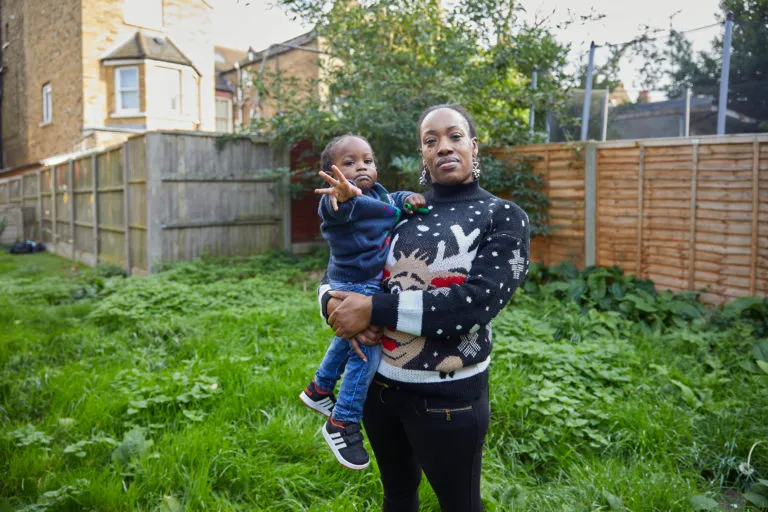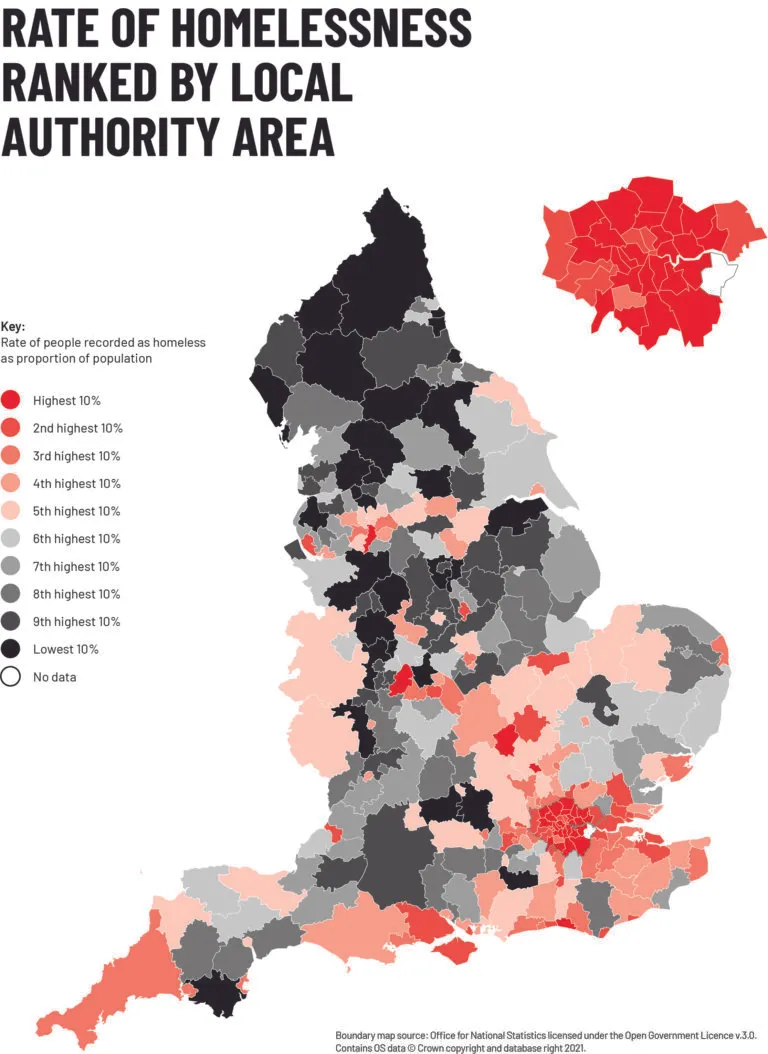The shocking scale of homelessness in England
Published: by Charlie Berry

Our new figures published today reveal that 274,000 people in England are recorded as homeless. In some parts of the country, an estimated 1 in every 22 people lacks a home of their own, living in temporary accommodation, hostels or on the streets. In this blog, we take a closer look at the figures to show the most severe impact of the housing emergency we face.
Majority of people recorded as homeless are in temporary accommodation
Almost a quarter of a million homeless people (249,850) are living in temporary accommodation provided by local councils. With a severe lack of affordable public housing for people to move on to, many families get stuck in homeless accommodation and can spend months and even years waiting for a settled home of their own.
Sarah and her family (pictured above) were homeless for three years after being evicted and spent months living in totally unsuitable temporary accommodation before we were able to help her secure a safe and stable home of their own.
126,000 homeless under-18s
The awful fact is that more than 4 in 10 (46%) people recorded as homeless are children and young people who are homeless with their families – over 126,000, the vast majority of whom (124,290) are stuck in temporary accommodation. This form of homelessness is hidden away, which is why most people think of homeless people as adults on the street.
But homelessness is much wider than temporary accommodation
Other elements which make up recorded homelessness include people who are living in homeless hostels (14,729), those who sleep on the streets (2,688) and families who are homeless and accommodated by social services (3,309). Our figures also include those who are ‘homeless at home’ (3,829). This latter group include those who have been found to be legally homeless by their local council because their current home is so unsuitable (e.g. severely overcrowded) it’s ‘unreasonable to continue to occupy’ or who have found their own temporary solution while the council try to help them access a settled home.
| [1] Est. no. of people homeless and living in TA arranged by the council as of 30 June 2021 | [2] Est. no. of people homeless and living in TA arranged by them or homeless at home as of 30 June 2021 | [3] No. of people sleeping on the streets on a given night | [4] Est. no single homeless people living in hostels | [5] No. people living in accommodation provided by social services | [6] Est. total no. homeless people | [7] Rate of homelessness (1 in X people) |
| 249,850 | 3,829 | 2,688 | 14,729 | 3,309 | 274,405 | 206 |
(England total – To calculate our figures we use data from the government, the voluntary sector and freedom of information requests sent to local authorities)
There are many forms of homelessness and our research does not include all those who lack a home but are not officially recorded as homeless, such as those who are sofa surfing but haven’t applied for, or been accepted for help, by the council. This means the true level of homelessness will be even higher than today’s figure.
Homelessness is most prevalent in London, but there are hotspots outside of the capital too
In England overall, 1 in every 206 people is recorded as homeless. But in some parts of the country, this rate is much higher.
The heat map shows that our cities are the worst affected places. In London, 1 in every 53 people is recorded as homeless. In fact, 19 of the worst affected 20 local authorities in the country are in the capital. There are high rates right across the city from Newham in the east, where 1 in every 22 people are recorded as homeless, to Kensington & Chelsea in the west, where the rate is 1 in 29 people. Big cities across the country also have shocking levels: rates in Manchester (1 in 81) and Birmingham (1 in 96) are among the highest in England.

(Map showing the rate of homelessness in England ranked by Local Authority areas)
But homelessness is not just a problem of our big cities, as the regional table shows. In fact, some of the worst affected places are towns. Luton in Bedfordshire has a higher rate of homelessness than Manchester, at 1 in every 66 people. And Milton Keynes (1 in 94 people) has a level of recorded homelessness comparable to Birmingham. In Yorkshire and the Humber, Rotherham has the highest rate of recorded homelessness (1 in every 612 people), outranking its far larger neighbour Sheffield (1 in 1,136 people).
Homelessness tends to be worse in places where housing is unaffordable for people on average or below-average incomes, due to income inequality which means they cannot compete for private rents and a lack of affordable social housing.
| Regional rank | Local authority | [1] Est. no. of people homeless and living in TA arranged by the council as of 30 June 2021 | [2] Est. no. of people homeless and living in TA arranged by them or homeless at home as of 30 June 2021 | [3] No. of people sleeping on the streets on a given night | [6] Est. total no. homeless people | [7] Rate of homelessness (1 in X people) |
| East of England | ||||||
| 1 | Luton | 3,231 | 0 | 15 | 3,246 | 66 |
| 2 | Harlow | 639 | 0 | 4 | 643 | 136 |
| 3 | Basildon | 1,137 | 0 | 3 | 1,140 | 165 |
| East Midlands | ||||||
| 1 | Nottingham | 1,083 | 0 | 31 | 1,114 | 303 |
| 2 | Leicester | 664 | 0 | 12 | 676 | 524 |
| 3 | W Northamptonshire | 560 | 71 | 13 | 644 | 632 |
| London | ||||||
| 1 | Newham | 15,794 | 0 | 6 | 15,800 | 22 |
| 2 | Kensington & Chelsea | 5,353 | 0 | 21 | 5,374 | 29 |
| 3 | Haringey | 8,673 | 0 | 8 | 8,681 | 31 |
| North East | ||||||
| 1 | Middlesbrough | 110 | 0 | 8 | 118 | 1,197 |
| 2 | Gateshead | 102 | 39 | 0 | 141 | 1,435 |
| 3 | N Tyneside | 141 | 0 | 3 | 144 | 1,450 |
| North West | ||||||
| 1 | Manchester | 6,780 | 0 | 68 | 6,848 | 81 |
| 2 | Salford | 635 | 4 | 8 | 647 | 406 |
| 3 | Oldham | 443 | 0 | 2 | 445 | 534 |
| South East | ||||||
| 1 | Brighton & Hove | 3,708 | 0 | 27 | 3,735 | 78 |
| 2 | Milton Keynes | 2,859 | 0 | 18 | 2,877 | 94 |
| 3 | Epsom & Ewell | 588 | 0 | 3 | 591 | 137 |
| South West | ||||||
| 1 | Bristol | 1,922 | 0 | 50 | 1,972 | 236 |
| 2 | Gloucester | 299 | 14 | 11 | 324 | 401 |
| 3 | Torbay | 263 | 32 | 19 | 314 | 434 |
| West Midlands | ||||||
| 1 | Birmingham | 11,867 | 0 | 17 | 11,884 | 96 |
| 2 | Coventry | 1,345 | 30 | 8 | 1,383 | 274 |
| 3 | Solihull | 357 | 132 | 1 | 490 | 443 |
| Yorkshire and the Humber | ||||||
| 1 | Rotherham | 427 | 0 | 6 | 433 | 612 |
| 2 | Kingston u. Hull | 260 | 131 | 19 | 410 | 633 |
| 3 | Wakefield | 466 | 8 | 4 | 478 | 736 |
Thousands more people could become homeless in the coming months
We know that the measures the government took during the pandemic, including the eviction ban and the ‘Everyone In’ approach to get people off the streets, have helped many people keep a roof over their heads. But with the eviction ban and furlough scheme over, the £20 Universal Credit cut and the cost of living rising, we’re worried that thousands more people will face homelessness in the coming months.
People who are recorded as homeless are experiencing the worst effects of the housing emergency facing the country. We know that homelessness negatively impacts people’s lives, including their mental and physical health and their children’s health, education and development. It is a symptom of a failed housing system.
Our report with full details of our methodology and local homelessness rates across England is available on our website.